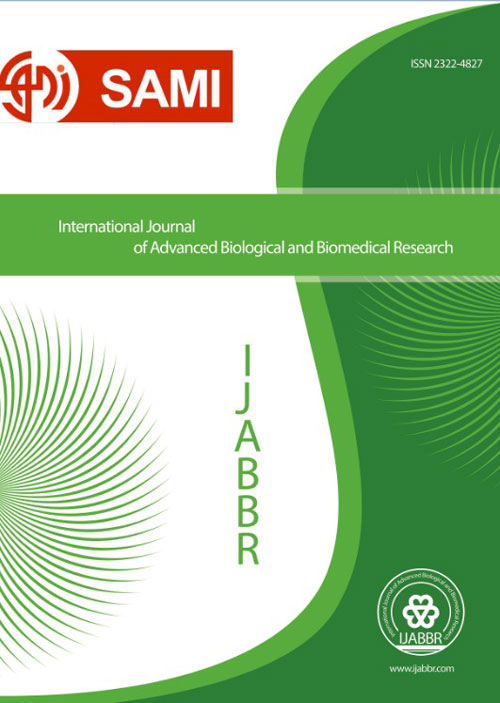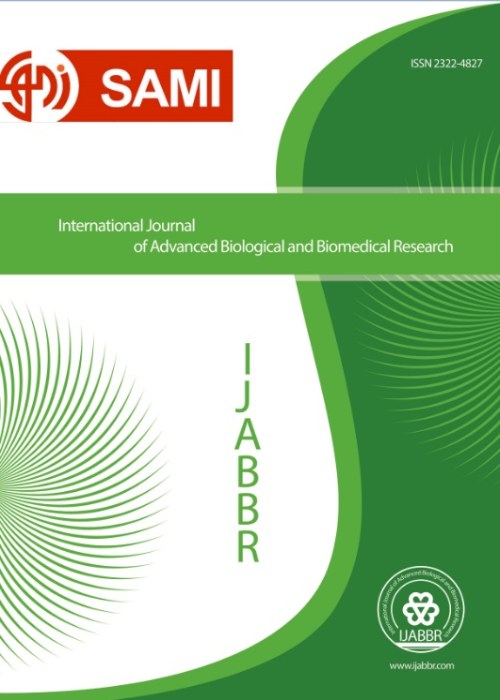فهرست مطالب

International Journal of Advanced Biological and Biomedical Research
Volume:10 Issue: 3, Summer 2022
- تاریخ انتشار: 1401/06/20
- تعداد عناوین: 7
-
-
Pages 185-193BackgroundCadmium (Cd) is an environmental pollutant known to be toxic to lung tissue. Crocin is an active phytochemical of saffron with antioxidant properties. Because of this characteristic, it is hypothesized that crocin can reduce the harmful effects of toxic chemicals. The current study aimed to investigate the crocin intervention on the expression of NRAS, KRAS, c-FOS, and c-JUN genes in the lung tissues of Cd-treated rats.MethodsIn this study, 40 Wistar rats (180±30 g) were randomly divided into four groups: the control group, received food and water; the crocin-treated group, received 15 mg/kg crocin orally; the Cd-treated group, received 20 mg/kg Cd by gastric gavage; and the complex group, treated by crocin and cadmium with previously mentioned concentrations. After eight weeks daily administered, the rats were euthanized, and their lungs were extracted to assess NRAS, KRAS, c-FOS, and c-JUN gene expressions by Real-Time PCR. Data were computed by GraphPad Prism (v.8). One-way ANOVA test was used as statistical analysis, and P<0.05 was considered statistically significant.ResultsThe results revealed that the Cd consumption raised the expression of all four genes in lung tissue (c-JUN, KRAS P<0.001, NRAS P<0.01, and c-FOS P<0.05). Crocin significantly reduced the expression of c-JUN (P<0.0001), c-FOS, and NRAS (P<0.05) genes.ConclusionThe data obtained from the current study indicated that crocin could reduce the expression of c-FOS, c-JUN, and NRAS as vital players in cell proliferation.Keywords: Lung Damage, Cadmium, Crocin, Cell proliferation, NRAS, KRAS, c-Fos, c-JUN
-
Pages 194-201BackgroundAntibiotics are widely used in poultry industry for prevention and therapy purposes. Due to non-compliance withdrawal times and improper use of antibiotics, it is a major public health and food security issue. The administration of antibiotics is one of the primary causes of antimicrobial resistance. It also may cause health problems such as genotoxic, carcinogenic, immunotoxic, or endocrine effects, allergic reactions, and changing natural micro flora of consumers.MethodsThis study focuses on detection of antibiotic residues in the chicken tissue samples. 250 chicken liver, heart, muscle, gizzard, and skin samples were collected from Tabriz slaughterhouse. Four plate test as a microbiological method was used for detecting and analyzing antibiotic residues. This method is based on inhibition zone formation around the tissue samples in four culture media with different test bacteria and pH. To investigate the existence of enrofloxacin and ciprofloxacin residues, another extra plate containing Escherichia coli was added to the test. The sample analysis was done by using 1.5 g of each tissue.ResultsAmong 250 samples including liver, muscle, gizzard, heart, and skin, 92% of liver samples, 12% of heart samples, 90% of skin samples, and 42% of muscle samples were contaminated by antibiotic residues. All the gizzard samples were free of antibiotics, while the most contaminated tissues were skin samples.ConclusionFour plate test is an easy and appropriate method for applying in laboratories. The results focus on considering strict legislation for using veterinary drugs in poultry in Iran.Keywords: Antibiotic residue, Chicken tissues, Four plate test, Enrofloxacin, Ciprofloxacin.
-
Pages 202-207Introduction
The charged particles emit electromagnet radiation due to the ionization and excitation of atoms while stopping in the environment. The energy spectrum and irradiation intensity depend on the type and the content of ingredients in the target and their thickness.
MaterialsThe spectrum of the produced X-rays has been examined by placing layers made of metals and other materials as well as changing their thickness in front of the inlet window of the CsI(Tl) scintillation detector. The CsI(Tl) scintillation detector channels have been calibrated using the 60Co and are represented in terms of energy versuce MeV.
ResultsResults revealed that iron with a thickness of 0.2 mm is the best candidate for producing X-rays. Besides, aluminum and paper are capable of producing X-rays with uniform distribution in the ranges of 0.383-2.357 MeV and 0.383-0.560 MeV, respectively.
ConclusionResults show that the maximum X-ray radiation intensity with the energy of 383 keV is produced due to the stoppage of alpha particles in the iron sheet with a thickness of 0.2 mm. Plastic, aluminum, paper, copper, and lead with X-ray radiation (383 keV) with thicknesses of 0.1-0.4 mm are available, respectively.
Keywords: X-ray, Electromagnetic Radiation, Scintillation detector. -
Pages 208-218IntroductionLead is one of the environmental pollutants and it is among the most important causes of oxidative stress in biological tissues. In this study, the effects of lead acetate on testicular tissue destruction were investigated. Ferulic acid (FA), which is an antioxidant and reduces free radicals, is expected to be effective in improving testicular function in lead-infected rats.Materials and methodsFor this study, 24 white male Wistar rats, categorized in four groups: control, lead acetate toxicity, FA control, and lead-Ferulic Acetate, were treated in the laboratory for 56 days. At the end of the treatment period, the rats were anesthetized and after blood sampling, they were analysed. Then, histological analysis was performed after testicular resection. To evaluate sperm characteristics, the distal part of the testicular epididymis was finally cut and fragmented.ResearchFindingsIn examination of testicular tissue sections in the samples, it was observed that the mean diameter of seminiferous tubules in samples with lead acetate poisoning was decreased more than the control, whereas in the group with FA treatment, the diameter was increased. Increased bleeding in the space between seminiferous tubules and tissue vacuolation were also recorded in the lead acetate group, but it was improved in the treatment group. The number, motility, percentage of normal sperm, and survival percentage of sperm which had a significant decrease in the lead acetate group, and were increased in the FA-treated group. Likewise, testosterone levels, which had a significant drop in the lead acetate poisoning group, were increased in FA-treated group.DiscussionThe result showed that lead acetate, with its destructive effects on testicular tissue, reduces the number of healthy and mature sperms, and ultimately leads to mice fertility of these mice, but ferulic acid which acts as an antioxidant has recovery effects against lead acetate.Keywords: Ferulic acid, Lead, Oxidative stress, Free radicals, Sperm.
-
Pages 219-228BackgroundCOVID-19 is a systemic infection with a significant impact on the hematopoietic system and hemostasis. Infected subjects are at high risk for coagulation diseases such as venous thromboembolism.ObjectivesThe aim of the present study was to investigate the consequences of delayed referral of patients with COVID-19 in Ilam.MethodsIn this investigation, a present prospective study was performed in 2020 on the registry data of patients with COVID-19 disease in the infectious ward of Shahid Mostafa Khomeini Hospital in Ilam. In this study, the effect of delay in hospitalization from the onset of the first symptom of the disease on death and intubation of patients in special and general wards in 2350 patients with COVID-19 was investigated. The statistical software of SPSS 16 was used for analyzing data.ResultsThe results of univariate logistic regression analysis for the main causes of death due to COVID-19 disease according to hospitalization in ICU and general ward showed that the variables of age, sex, marital status, heart disease, blood pressure, diabetes, chronic lung disease, chronic disease Kidney, neurological disease, cancer, and delayed referral were statistically significant which were associated with death at the 5% error level. The chance of death for delayed referral in ICU patients is equal (OR ICU ADMISSION = 1.06; 95% CI, 1.01-1.12; P value=0.01) and in normal ward patients (OR =0.88; 95% CI, 0.79-0.97), the P-value=0.01 was obtained.ConclusionsThe final regression model which was adjusted to the other variables, in hospitalized patients, each day of delay in hospitalization meant a 0.08% increase in the odds of mortality rate and a 0.05% increase in the odds of intubation.Keywords: Referral delay, Complications, COVID-19.
-
Pages 229-236Background
Increasing the satisfaction of students with the advisors can help to improve the educational status of students. Therefore, this study aimed to investigate the performance of advisors from the viewpoint of medical students in Iran in the form of a systematic review.
MethodsIn this study, all studies on the performance of advisors of universities of medical sciences were reviewed from the students' viewpoint and students' satisfaction with the professors' performance systematically. The national databases of Iran and international databases were searched and the data and articles were entered EndNote version 7.
ResultsResults showed that 155 articles were searched at the first stage. 93 articles were excluded from the search at the first stage, and finally, a systematic review was conducted with 11 original articles. Also, 662 faculty members and 5697 students of 11 universities of the country including Kerman, Babol, Shiraz, Kurdistan, Rafsanjan, Alborz, Sabzevar, Urmia, Lorestan, Mashhad, and Semnan universities were investigated. Likewise, from the students' viewpoint, the professors' performance was in a range from poor to excellent. In addition, the level of satisfaction with the performance of the advisors from the students' viewpoint varied from poor to excellent.
ConclusionAccording to the study results, it is suggested to hold training workshops on the necessary methods for the advisors’ principles while revising job description of advisors.
Keywords: Advisors' performance, Medicine, Faculty, Medical Students. -
Pages 237-244Background and Objective
Vaccines are medical devices used for boosting the health of people, especially children. This study was performed to determine the prevalence of the side effects of a new pentavalent vaccine in 2- to 6-month-old children in Ilam.
Materials and MethodsThis descriptive cross-sectional study was performed on 2-6-month-old children for inoculating the pentavalent vaccine. A questionnaire containing queries on the age of child, parents’ education, contact number, injection date, gestational age, the underlying diseases, failure to thrive (FTT), and side effects (diarrhea, vomiting, nausea, redness, fever, intense crying, restlessness, drowsiness, stiffness, etc.).
ResultsOf the children, 35.9% were two months old, 31.8% were four months old, and 32.3% were six months old. Boys and girls constituted 53% and 47% of children, respectively. Regarding mothers’ education, 54.5% had lower than diploma degrees, and 6.1% had academic education. Regarding fathers’ education, 13.2% had lower than diploma, and 12% had academic degrees. Most of the children (94.4%) had no underlying diseases, and 5.6% of them suffered from the underlying diseases including reflux (1.6%), anemia (2.3%), favism (0.9%), fever and convulsion (0.7%), and hypothyroidism (0.2%). The most common complications were fever (68.1%), skin redness (56.1%), pain (43.8%), and restlessness (24.7%). Fever (69.2% vs. 66.8%, P>0.05), skin redness (65.2% vs. 45.8%, P<0.05), vomiting (10.5% vs. 3.3%, P<0.05), and stiffness (6.6% vs. 3.3%, P>0.05) were more common in boys than girls, respectively. On the other hand, restlessness (35.8% vs. 14.8%, P<0.05) was significantly higher in girls than in boys.
ConclusionAccording to our results, fever, skin redness, and pain were the most common complications. Fever was more common in 2-month-old boys, and pain was more observed in 6-month-old girls. Most of the side effects were transient and disappeared upon a week. No remarkable contraindications were reported, confirming the safety of the vaccine.
Keywords: Complications, Vaccine, Pentavalent, Children, Vaccination


